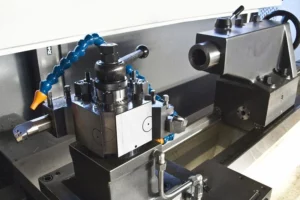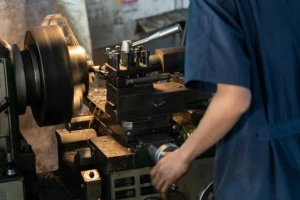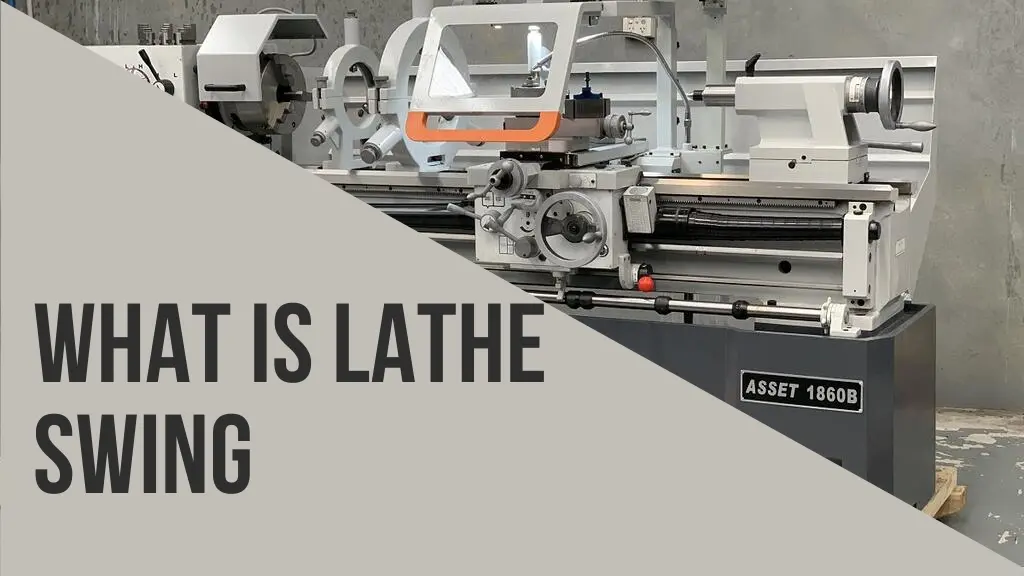Learn about lathe swing and its significance in machining. So, explore how lathe swing impacts workpiece size and versatility in various manufacturing.
Understanding Lathe Swing
Whether a lathe is used for woodworking or metalworking, a lathe swing is essential. It describes the most significant piece of material that the lathe can handle. The largest diameter of a workpiece that can fit and rotate freely within the lathe without obstructing any of the lathe parts is essentially measured by the swing.
So In the past, the diameter of an object was represented by the swing of a lathe, which was the distance from the spindle’s center to either end of the workpiece. However, particularly in Europe, you might find some lathes whose swing refers to a radius on the market. So with the help of a store employee or a quick Google search, this is simple enough to confirm.
How To Measure Lathe Swing Size

Measuring your lathe’s swing size is easy. Here’s how you can do it:
- Find the Middle: Locate the center of your lathe’s spinning part (spindle). This ensures accurate tool alignment and precise cutting during operation.
- Measure to the Bed: From the spindle’s center, measure to the lathe’s bed. This gives you the most extensive range. Knowing this distance helps determine the maximum workpiece diameter your lathe can handle.
- Double It: If you want to know the full width, double the distance you measured. That gives you the swing size. For example, if you measured 7 inches to the bed, doubling it makes it 14 inches. So, your lathe’s swing size is 14 inches. Remember, use workpieces only for the lathe swing size. Now you’re all set for lathe work!
Exploring Lathe Swing Components
A lathe swing machine is made up of essential parts that work together to get things done. Let’s understand them in simple terms:
- Bed: The bottom part that holds everything. It needs to be vital to keep things steady and accurate. A solid, well-constructed base minimizes vibrations and enhances machining precision.
- Headstock (Spindle): This part holds and spins the thing you’re working on. It needs to be balanced and well-built for good results. Any imbalance can lead to vibrations, affecting both safety and the quality of the finished workpiece.
- Carriage: It’s like a moving table where your tools are placed. It can slide back and forth to shape the material. Smooth and precise movement of this part is essential for accurate cuts and consistent finishes.
- Compound: A platform that holds your tools and can tilt to different angles. So this helps in making various cuts. Adjusting it properly ensures flexibility and precision when shaping complex profiles.
- Cross Slide: Part of the carriage that helps move your tools smoothly along the machine. It ensures controlled, even motion for accurate and consistent cutting operations.
- Tailstock: It supports your workpiece from the other end. You can also use it for drilling. Adjusting it correctly ensures stability and prevents the material from flexing or vibrating during operation.
By understanding these parts, you’ll know how a lathe machine works and how to use it for different tasks.
Different Types Of Lathe Swing
- Swing Over Bed: The phrase “swing over bed” refers to one typical swing measurement. Simply put, this refers to the largest size of an object that can be turned over the lathe bed without becoming damaged. Its size can be determined by using a ruler to measure the distance from the spindle’s center to the bed and doubling the result.
- Swing Over Carriage: This measurement is another one. This indicates that the largest size of the object that can be easily rotated on the lathe is a carriage. So, measure the spindle to the top of the carriage, double it, and that is the swing over the carriage.
- Wing over compound: The largest object that can safely swing over a compound: swing over the compound of a lathe is referred to as “swing over the compound.” Calculate the size by taking another measurement from the spindle’s center to the compound and doubling it.
- Other Swing Types: You may see various swing measurements on the label, depending on the brand and location of the manufacturer of your lathe. For example, “swing over cross slide” or “swing over gap.” Find the component that these terms refer to (such as the gap or cross slide) and measure the distance from that point to the lathe spindle’s center to understand what they mean.
Extra Points You Need To Keep In Mind

- When buying a lathe machine, there are a few extra things to keep in mind to avoid any hassles while using it. Sometimes, the labels provided by lathe manufacturers need to be more accurate, or the measurements could be slightly off.
- If the swing measurement on the label doesn’t match your expectations, you should deal with the inconvenience of returning or exchanging the lathe.
- Additionally, So keep in mind that the units of measurement, like the metric system, might differ, which can lead to confusion.
- So you must Be aware of these possibilities and be prepared to address any discrepancies, which can save you time and effort in the long run.
- By double-checking the swing size and ensuring its compatibility with your intended projects, you can make a more informed choice when selecting a lathe. Remember, there are different types of measurements to consider as well.
Conclusion
Machine tools, often called “mother machines,” play a crucial role in creating other machines. Among these, the lathe stands out as one of the most essential machine tools in machining.
Might not be commonly encountered in our everyday experiences, so a significant portion of the products we rely on daily incorporate parts crafted using machine tools. So, if you come across cylindrical components in your daily life, chances are they were shaped with the help of a lathe.
FAQs
What is a lathe used for?
A lathe is a machine tool for creating symmetrical parts along an axis, in addition to external and internal cylindrical surfaces and conical surfaces.
Is the lathe swing measured by diameter or radius?
A lathe swing is the largest workpiece diameter a lathe can handle, so measured as the radius in some regions like England.




